Argentina has the most swine flu deaths outside the United States, but the virus is still killing fewer people than normal seasonal flu — good news for a world waiting to see how it evolves in the southern winter.
And despite fears that the virus will mutate and turn more deadly, genetic sequencing shows this influenza remains virtually identical to what is circulating in the U.S. and Mexico, making it more likely that a single vaccine can work around the world.
With more than a month still to go in the southern winter flu season, swine flu infections have peaked in Argentina. Doctor visits by people with flu symptoms have declined sharply. Hospital beds are available for the first time in weeks.
The A-H1N1 virus has probably spread so widely now that there are fewer susceptible people left to infect, flu experts say. And while the global epidemic is still in its early stages, there have been no signs of resistance to antiviral drugs in Argentina, so it's possible that Tamiflu will remain effective in patients who get timely treatment.
The bad news: Young healthy people are getting sicker and dying more often than other age groups, just like they are elsewhere in the world.
"Compared to other influenzas, the death toll won't be any greater, but we are probably going to see a much greater impact on the young," said Dr. Vilma Savy, who runs the respiratory virus service at Argentina's National Institute of Infectious Diseases.
Don't relax yet
Argentina is among several countries that stopped publishing its death toll. Health Minister Juan Manzur called it misleading, since only serious cases get tested. But an Associated Press survey of provincial reports found at least 248 swine flu deaths. That's high compared to the 353 confirmed deaths in the United States, which has seven times more people, and far higher than any of Argentina's South American neighbors.
Dr. Elsa Baumeister, who is coordinating the institute's swine flu response, says it's too early to relax.
"The numbers are still quite raw," she said. "We have to be careful."
Manzur estimates more than 100,000 Argentines have swine flu right now — a number Baumeister believes is quite conservative. That would result in a mortality rate of less than 0.2 percent, well below Argentina's death rate of 0.27 percent from seasonal flu last year.
Meanwhile, with winter only months away in the Northern Hemisphere, wealthy countries have already reserved vast quantities of vaccines and antiviral drugs for their citizens. Many fear the developing world will be left out, and can ill afford to buy the expensive drugs in any case.
Argentina's president, Cristina Fernandez, wants the World Health Organization to guarantee their availability to poorer countries — and to enlist labs in Argentina and Brazil to help produce swine flu vaccines.
"We're confronting a situation in which the needs of millions of people cannot be subordinated to economic interests," Fernandez declared at a South American trade summit last week.
The two Argentine strains sequenced so far — taken from a gravely ill patient and another who hardly suffered — were isolated at the institute's level 3 biohazard laboratory — one of very few in Latin America capable of handling the world's most dangerous pathogens. The lab is now dedicated to swine flu, confirming 300 or more infections a day.
This same institute, nearly a century old, responded to the 1918 flu pandemic and produced smallpox vaccines that helped save a generation of soldiers years later. Savy's plan is to enlist the WHO and use the swine flu pandemic as leverage to boost Argentina's capacity to make a variety of vaccines for other killer diseases as well.
Response to the outbreak
Argentina initially downplayed the pandemic. Fernandez hardly mentioned it before the nation's June 28 midterm elections, and resisted declaring a health crisis even as deaths mounted and the public health system was swamped. Tourism plunged — the number of airplane passengers from Brazil dropped by half, and Argentina's winter resorts have been empty.
But the government responded forcefully in July — closing schools weeks early for the winter holiday and giving pregnant women and other vulnerable workers 15 paid days off. As hospitals set up extra beds in waiting rooms and hallways and bought extra respirators to handle the caseload, Manzur took the nation's supply of antiviral drugs out of private pharmacies and made 2 million courses of Tamiflu available for free at public hospitals.
Few Argentines wear masks now, but many remain wary. Absenteeism is expected to be so high when schools reopen Monday in Buenos Aires that Manzur vowed to send social workers to the homes of children who don't show up. Brazil also extended its winter school holiday, but swine flu fears are keeping millions of students there at home as well.
Some cherished traditions have suffered. In a culture where male and female friends alike greet each other with a kiss on the cheek, people keep a wary distance. Many won't even share their mate (pronounced MAH-teh), the omnipresent herbal drink that Argentines usually pass around and sip through a common metal straw.
"Only with family and close friends," rancher Julio Fernandez said as he shared a large mate while tending to his prize bull at La Rural, Argentina's largest annual agricultural fair. "It's a symbol of friendship — you can't take that away — but you also have to be careful with this influenza."
